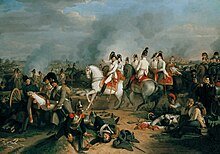Historical Context and Prelude to the Battle
The Battle of Aspern-Essling, fought on May 21st, 1809, stands as a pivotal moment in the Napoleonic Wars, marking Napoleon Bonaparte’s first significant defeat in a decade. To grasp the importance of this confrontation, it is essential to delve into the geopolitical landscape of early 19th-century Europe. At the turn of the century, Napoleon had embarked on an ambitious campaign to secure dominance over the continent. His series of military successes had established French hegemony, compelling numerous European states to either ally with or submit to French influence.
By 1809, Europe was a tapestry of shifting alliances and enmities. The Treaty of Pressburg (1805) had ended the War of the Third Coalition, temporarily halting major hostilities between France and Austria. However, the peace was fragile. Napoleon’s continuous expansion of the French Empire and the formation of the Confederation of the Rhine alarmed many European powers, most notably Austria. Emperor Francis I of Austria, determined to restore his realm’s influence, found a capable leader in Archduke Charles, his younger brother and one of Europe’s most competent military strategists.
Archduke Charles recognized that confronting the French would require not just military might but innovative tactics and thorough preparation. He began reorganizing the Austrian army, improving its training, and adopting new strategies to counter French maneuvers. His efforts culminated in a renewed Austrian offensive in 1809, aiming to reclaim lost territories and diminish French dominance.
Napoleon, confident in his past victories, approached the Austrian campaign with characteristic zeal. His rapid movements had often caught enemies off-guard, and he intended to employ similar tactics against Archduke Charles. However, the battle near Vienna would prove different. The crossing of the Danube River was a logistical challenge that exposed French vulnerabilities. The Austrians, well-prepared and strategically positioned, seized the opportunity to engage the French forces decisively.
The stakes for both sides were immense. For Napoleon, a victory at Aspern-Essling would consolidate his control over Central Europe and dissuade other powers from challenging him. For Austria, defeating the French would ignite hope for liberation across Europe and demonstrate that Napoleon’s forces were not invincible. The confrontation on May 21st, 1809, thus set the stage for a critical juncture in the Napoleonic Wars, one that would reverberate through subsequent military and political developments.
The Battle and Its Aftermath
The Battle of Aspern-Essling, which took place on 21st May 1809, marked a significant turning point in the Napoleonic Wars. Napoleon’s forces, crossing the Danube near Vienna, were met by Archduke Charles’s well-prepared Austrian army. The battle began with Napoleon’s initial success in establishing a bridgehead across the river. However, the tide quickly turned as the Austrians executed a series of tactical maneuvers that would cripple the French advances.
Archduke Charles capitalized on the French army’s vulnerabilities, particularly their precarious position between the Danube and the villages of Aspern and Essling. The Austrian forces launched relentless attacks, exploiting gaps in the French lines. Key skirmishes unfolded around these villages, with intense fighting resulting in heavy casualties on both sides. The French, although initially holding their ground, struggled to maintain their supply lines due to persistent Austrian artillery fire, which severed their pontoon bridges.
On 21st May 1809, the Austrians managed to isolate and overwhelm segments of the French army. The breakdown of the bridges played a critical role in hampering Napoleon’s ability to reinforce and resupply his troops effectively. Despite several counterattacks, including efforts from Marshal Lannes, the French were forced into a defensive stance. By the second day, the situation worsened for Napoleon, leading to a tactical withdrawal across the Danube.
The aftermath of the Battle of Aspern-Essling revealed several tactical errors and vulnerabilities within Napoleon’s army. The defeat exposed the risks of overextending supply lines and the dangers of underestimating an opponent’s capability to mount a coordinated defense. This battle was not only a blow to Napoleon’s military strategy but also had significant repercussions for his broader campaign for European dominance. The morale of the French troops, once seen as invincible, was notably shaken.
Strategically, the Battle of Aspern-Essling underscored the importance of logistics and the need for adaptable tactics in the face of changing battlefield conditions. The lessons learned from this defeat influenced subsequent engagements, compelling Napoleon to reconsider his approach in future conflicts. Historical accounts and eyewitness testimonies from this battle provide a vivid narrative of the chaos and valor displayed on both sides, enriching our understanding of this pivotal moment in military history.

